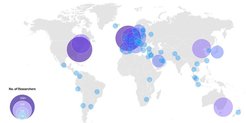Ilme Schlichting and Stefan W. Hell among influential authors
76 Max Planck scientists among the most highly cited researchers 2018.

This year, a new category has been introduced to recognize interdisciplinary work. The cross-field category reflects the fact that an immunologist today is likely to be both a biochemist and molecular biologist, and a chemist is can be a materials scientist or even an engineer. 24 Max Planck scientists alone are assigned to this new category, including Svante Pääbo from the Max Planck Institute for Evolutionary Anthropology in Leipzig, Ilme Schlichting from the Max Planck Institute for Medical Research in Heidelberg, and Ferdi Schüth from the Max Planck Institute for Coal Research in Mülheim.
The most important results at a glance:
- More than 4000 researchers in the natural and social sciences are listed. Approximately half of them were added to the list in 2018.
- With 2,639 authors, the United States constitute the largest group of influential scientists. 546 researchers from the United Kingdom are listed, and 482 from China.
- Scientists from Sweden, Austria, Singapore, Denmark, China and South Korea are the most successful in interdisciplinary research.
- This year's list includes 17 Nobel Laureates, including James P. Allison, who received the Nobel Prize in Physiology or Medicine this year, and William D. Nordhaus, who received the Prize in Economic Sciences in 2018.
- Australian research institutes are among the rising stars. Australia's position in the ranking has improved significantly since 2014, from 80 influential researchers to 170 in 2018.
- China has moved up to third place in the country ranking, putting Germany into fourth place. "Of course, you have to remember that the number of highly cited scientists also reflects the size of the country," says Lutz Bornmann, bibliometrician of the Max Planck Society.
- Publicly funded research organizations are particularly successful: The National Institutes of Health, which are responsible for biomedical and health-related research in the United States, rank among the top five science organizations, as do the Chinese Academy of Sciences and the Max Planck Society.
The methodology that determines the Who’s Who of high-impact researchers draws on the data and analyses performed by bibliometric experts from the Institute of Scientific Information at Clarivate Analytics. The publication and citation data come from the Web of Science, a web-based database for scientific and commercial purposes covering the scientific literature in over 30,000 journals.
(Barbara Abrell, General Administration Max Planck Society, Munich)
